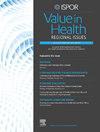Mapping KDQOL-36 Onto EQ-5D-5L and SF-6Dv2 in Patients Undergoing Dialysis in China
IF 1.4
Q3 HEALTH CARE SCIENCES & SERVICES
引用次数: 0
Abstract
Objectives
To develop mapping algorithms based on Kidney Disease Quality of Life-36 (KDQOL-36) scores to the EQ-5D-5L and SF-6Dv2 utility values among dialysis patients in China.
Methods
We used data from a cross-sectional multicenter survey in China to map the KDQOL-36 to the EQ-5D-5L and SF-6Dv2. The conceptual overlap between the KDQOL-36 and the EQ-5D-5L or SF-6Dv2 was evaluated using Spearman’s correlation coefficients. Direct mapping, including ordinary least squares, generalized linear model, beta regression model, Tobit regression model (TRM), censored least absolute deviations model, adjusted limited dependent variable mixture model (ALDVMM), response mapping, and seemingly unrelated ordered probit model, were used to derive mapping functions using the data set. Model performance was assessed by the mean absolute error (MAE) and root mean square error (RMSE) using cross-validation.
Results
A total of 378 patients (50.53% female; mean [SD] age: 49.05 [13.34]) were included in this study. The mean utility values of EQ-5D-5L and SF-6Dv2 were 0.72 and 0.57, respectively. When mapping to the EQ-5D-5L, the ALDVMM with 1 component was the best-performing model (MAE = 0.1579, RMSE = 0.2289). When mapping to SF-6Dv2, TRM was the best-performing model (MAE = 0.1108, RMSE = 0.1508). Generally, KDQOL-36 subscale scores and their squares were the optimal predictor set for each model. Overall, the models using KDQOL-36 subscale scores showed a better fit than those using the Kidney Disease Component Summary.
Conclusions
The ALDVMM and TRM models with the KDQOL-36 scores can be used to predict the EQ-5D-5L and SF-6Dv2 utility values, respectively, among dialysis patients in China.
在中国透析患者中KDQOL-36与EQ-5D-5L和SF-6Dv2的映射
目的开发基于肾脏疾病生活质量36 (KDQOL-36)评分到中国透析患者EQ-5D-5L和SF-6Dv2效用值的映射算法。方法利用中国多中心横断面调查数据,将KDQOL-36与EQ-5D-5L和SF-6Dv2进行比对。KDQOL-36与EQ-5D-5L或SF-6Dv2之间的概念重叠使用Spearman相关系数进行评估。利用普通最小二乘、广义线性模型、beta回归模型、Tobit回归模型(TRM)、删除最小绝对偏差模型、调整有限因变量混合模型(ALDVMM)、响应映射和看似不相关的有序概率模型等直接映射方法推导映射函数。通过交叉验证,采用平均绝对误差(MAE)和均方根误差(RMSE)来评估模型的性能。结果共378例患者,其中女性50.53%;平均[SD]年龄:49.05[13.34])被纳入本研究。EQ-5D-5L和SF-6Dv2的平均效用值分别为0.72和0.57。当映射到EQ-5D-5L时,具有1个分量的ALDVMM是表现最好的模型(MAE = 0.1579, RMSE = 0.2289)。当映射到SF-6Dv2时,TRM是表现最好的模型(MAE = 0.1108, RMSE = 0.1508)。一般而言,KDQOL-36子量表得分及其平方是各模型的最佳预测集。总体而言,使用KDQOL-36亚量表评分的模型比使用肾脏疾病成分总结的模型更适合。结论基于KDQOL-36评分的ALDVMM和TRM模型可分别用于预测中国透析患者的EQ-5D-5L和SF-6Dv2效用值。
本文章由计算机程序翻译,如有差异,请以英文原文为准。
求助全文
约1分钟内获得全文
求助全文
来源期刊

Value in health regional issues
Pharmacology, Toxicology and Pharmaceutics-Pharmacology, Toxicology and Pharmaceutics (miscellaneous)
CiteScore
2.60
自引率
5.00%
发文量
127
 求助内容:
求助内容: 应助结果提醒方式:
应助结果提醒方式:


